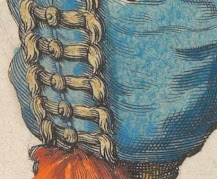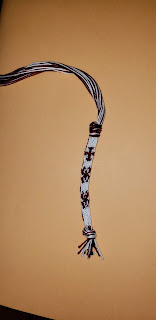As one of the early proponents for spears in my SCA Kingdom (Atlantia), and the current Kingdom Rapier Marshal, I get asked a lot about what spear heads to use for rapier spear. I decided to put all of the options I'm aware of together as a resource for other folks, along with what I know about them. They come from a variety of places: my searching, items coming through the Spears in SCA Fencing Facebook group, people showing me spear heads, etc.
Do NOT take any entry on this list as any kind of official endorsement. This page is put together by Private Citizen Percy, and not as any kind of official resource of the office of the Earl Marshal of Atlantia.
Just because an item is on this list does NOT mean the one you get will be legal. Manufacturing of some of these replicas appear to be inconsistent, so do test them against SCA rules before mounting and using them on the field.
As a reminder, rubber spear heads must be between 4" and 20", must extend 4" past the haft, must have at least a 2" socket for the haft (which I think then means they have to be a minimum of 6" long), with the tip having at least a thickness of 1/4". They must flex via hand pressure (who's hand pressure?) to 90 degrees and return to roughly their original shape within 3 seconds. (Paraphrased from the SCA Fencing Marshal's Handbook - refer to it for the current rules.)
| Item | Maker | SCA Legal | Comments |
|---|---|---|---|
| Partisan Head | Purpleheart Armory | Yes | I personally have one of these. It does pass the SCA flex test, but it's unwieldy as all get out on the end of 9 feet of rattan. Great for drills and learning control, because if you can hit properly with this you'll be able to control any other head on this list, most likely. |
| Spear Head | Purpleheart Armory | Yes | I have one of these, too. It does pass the SCA flex test. It's... stout. Be nice to your friends with this one. |
| Spear 4, Polymer Trainer | Purpleheart Armory | Unknown | I haven't seen one of these. I suspect it's too stiff, based on the product description. |
| Spear 1, Short, Helgi Polymer Trainer | Purpleheart Armory | Unknown | Haven't tried it. Reviews say very flexible, and the video looks like it has decent flex. Reports in spear FB group says it's good, but probably too flexible. |
| Sudanese Spear Head | Purpleheart Armory | No | Haven't tried it, but says in the description that it does not flex. Purpleheart has several others with similar descriptions, so I'm saving some space in this table by not listing them all. |
| Arcem winged spear head | Arcem | Yes | I own this spear head as well, and I think it's my personal favorite. It has a button head which means people notice being hit, but it flexes very well. My head looks like it's got a manufacturing defect, but it's held up so far. I just handled another one that's a little stiffer, but still fine. I got mine through an overseas vendor, but the one linked is a US supplier. |
| Arcem spear head mk 3 | Arcem | No | I purchased this one too. It's too stiff, almost no bend at all. |
| Arcem pike/javelin head | Arcem | No | Another one I've bought. Again, too stiff, and really small. |
| Arcem spear head mk 4 | Arcem | Unknown | The one Arcem product I haven't seen and also unavailble from US suppliers. |
| Cold Steel Spear head | Cold Steel | Varies | Ah, the original we all thought would be great. The original run was fine (and I have one and have seen lots of others), but a little floppy with a tendency to break at the socket if not seated properly. Any more recent manufacturing run has proven too stiff and will not pass. This was the cheapest option out there, so it's sad to see it not pass anymore. And no, there's no link for this one because it's easy to find. |
| Playwell spear head | Playwell | Yes | My KRM predecessor has one that passed when I saw it. Looks like it might fail closer to the tip rather than in the socket. I vaguely recall hearing that it may have gone the way of the Cold Steel with newer ones being stiffer, but that's anecdotal at best. |
| Fake Steel spear head | Fake Steel | Yes | I've seen one in person; someone in state has one. It looks a little cartoonish, but it hits solidly and safely. |
| Fake Steel pike head | Fake Steel | Probably | Same person who has the spear head recently purchased this, but I haven't seen it yet. I'd say it's probably good, but until I see it, i won't know for sure. |
| Cap-A-Pie 25mm Spear head | Cap-A-Pie | Unknown | The listed Shore hardness on this probably makes it a no. Also based on the picture, I'm not sure there's enough head after the socket to make it legal. |
| Cap-A-Pie 28mm Spear head | Cap-A-Pie | Unknown | Longer and bigger socket than the 25mm one, but probably with all the same issues. |
| Cap-A-Pie Javelin head | Cap-A-Pie | Unknown | No Shore hardness listed on this one, but it still has the same potential problem with not enough rubber above the socket. |
| Pikeman shop spear head | Pikeman | Unknown | Some comments from the Spears Facebook group mentioned that this head may be questionable, but it's an unknown for now. |
| Dark Victory Armory Spear head | Dark Victory Armory | Unknown | Short socket, very similar to the Purpleheart one (possibly about the same stiffness) according to FB comments. |
| Historica Spear trainer | Historica Clothiers | Unknown | Looks like the website is defunct. According to their Facebook page, they went offline last November. Not sure if it will come back, but leaving it here for historical purposes (hah, see what I did there) |
| Long spear head | Jolly Knight Armory | Unknown | Haven't seen this one in person either. The 5kg pressure listed in the description may be on the stiffer side, but I like the look of it. |
| Rogatina | Dominus Gladius | Probably | First saw this a few days ago. The Spears FB group says it's good, but might be too flexy. The manufacturer is in the group and very willing to answer questions as well as working with organizations to make acceptable products. They released a video on YouTube that shows the flex on many of their products. |
| Javelin | Dominus Gladius | Unknown | This looks very similar to the Arcem javelin or spear heads, but may be a slight bit larger. The flex in the video mentioned in the previous one looks borderline to me. |










